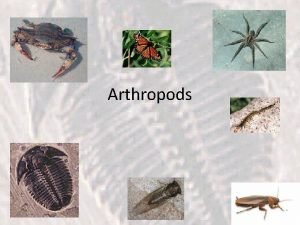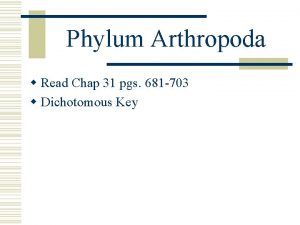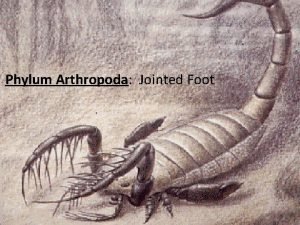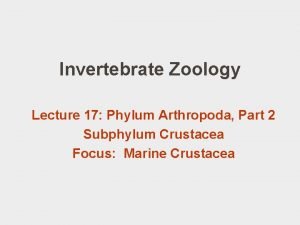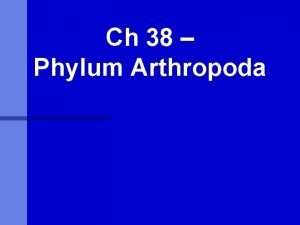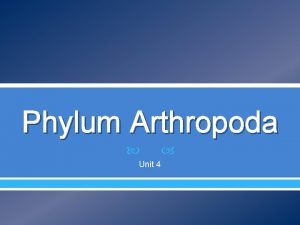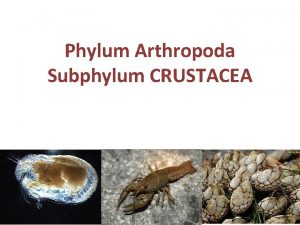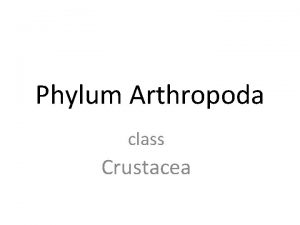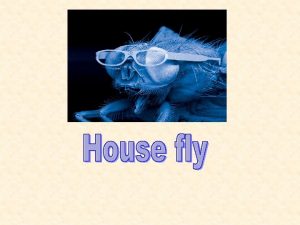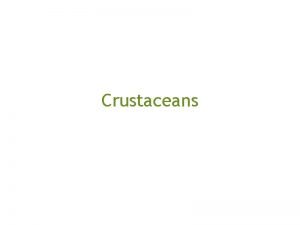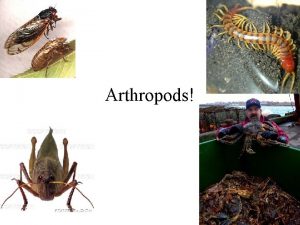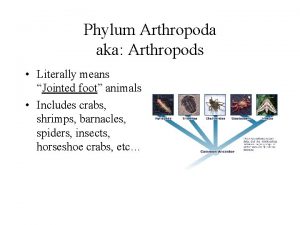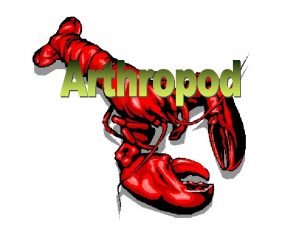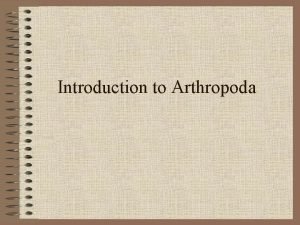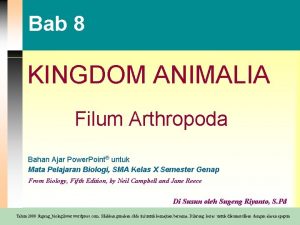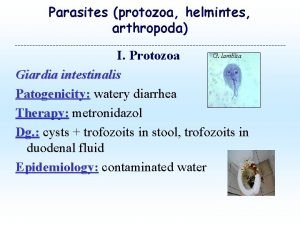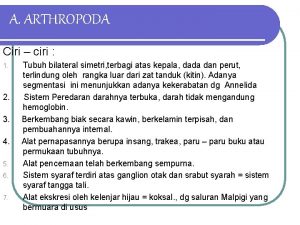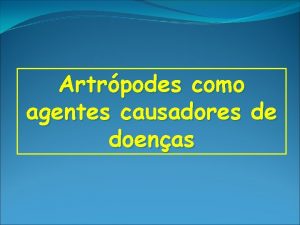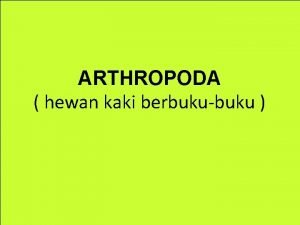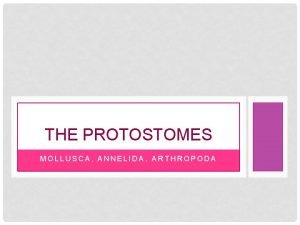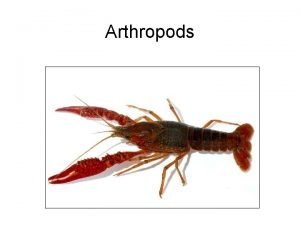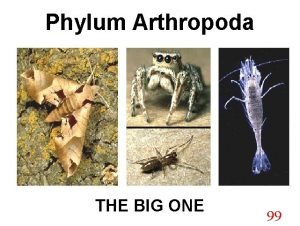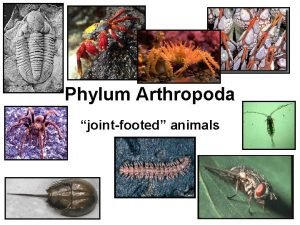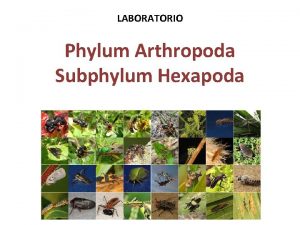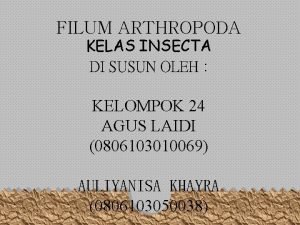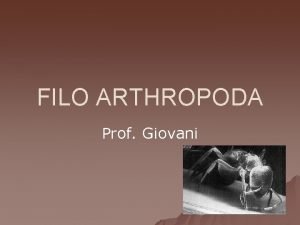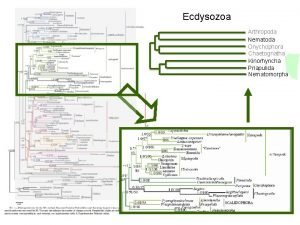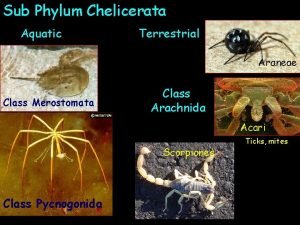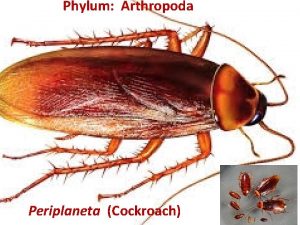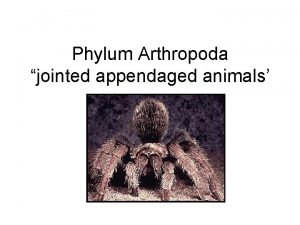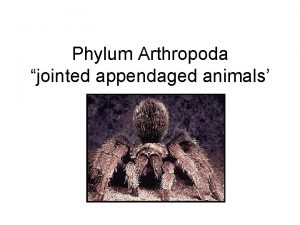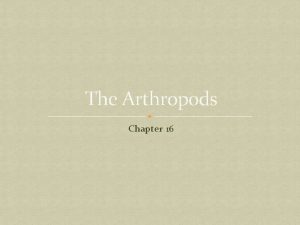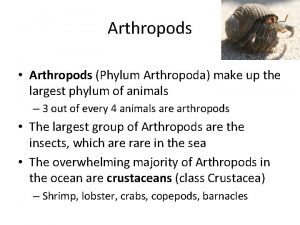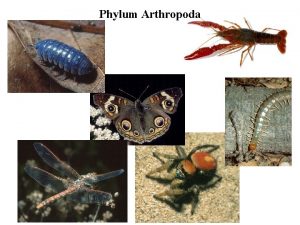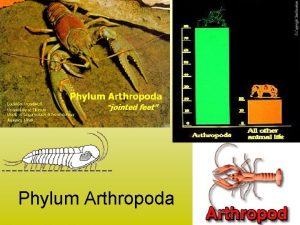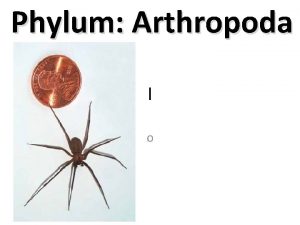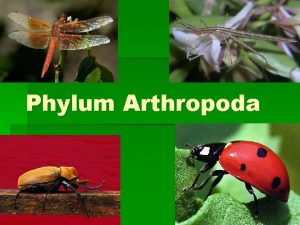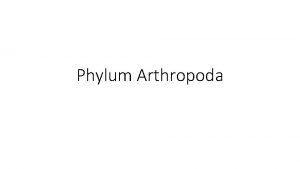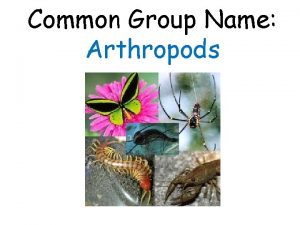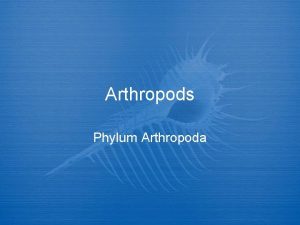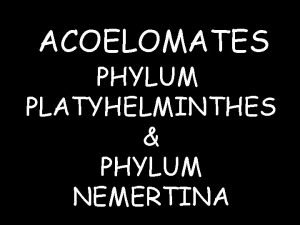Arthropods Week 6 Phylum Arthropoda Common name arthropods




































- Slides: 36

Arthropods

Week 6 Phylum: Arthropoda • Common name = arthropods • Ex. Insects, spiders, crabs, shrimp, centipedes, lobsters, ticks Monday

Arthropods • Arthropods have: – Segmented body • Head ⇛ Cephalothorax • Thorax • Abdomen – Tough exoskeleton made of chitin – Jointed appendages

Evolution of Arthropods • Led to – Fewer appendages – Few segments – Highly specialized appendages • • • Antennae Pincers Walking legs Flippers Claws

Feeding • Herbivores, carnivores, omnivores • Bloodsuckers, filter feeders, detritivores, parasites • Mouthparts range from pinchers to fangs to sickle-shaped jaws depending on diet

Respiration • Terrestrial – Breathe thru a network of branching tracheal tubes – Air enters through spiracles = little openings along body – Spiders uses book lungs • Aquatic – Featherlike gills – Horseshoe crabs have book gills

Circulation • Open circulatory system • Well-developed heart

Excretion • Terrestrial – Malpighian tubules = saclike organs that extract wastes from the blood and add them to feces (digestive wastes) • Aquatic – Diffusion

Response • Well-developed nervous system • All have a BRAIN

Movement • Muscles are attached to exoskeleton • Pull of muscles against exoskeleton allows arthropods to move • All have jointed appendages

Reproduction • Terrestrial – Internal fertilization • Aquatic – Internal or external fertilization

Growth and Development • Exoskeletons DO NOT GROW, arthropods must MOLT • Molting = arthropod sheds entire exoskeleton and makes a new larger one • Molting arthropods are vulnerable and hide until they are done

Crustaceans • • • Primarily aquatic Crabs, shrimps, lobsters, crawfish, barnacles 2 pairs of branched antennae 2 or 3 body segments Chewing mouthparts = mandibles Tuesday

Associated Vocabulary • Cephalothorax = fused body segment consisting of head and thorax • Abdomen • Carapace = part of exoskeleton that covers the cephalothorax • Mandible = biting, grinding mouthpart • Chelipeds = claws • Swimmerets = flipper-like appendages for swimming

Chelicerates • 2 body segments • Most have 4 pairs of walking legs • Horseshoe crabs, spiders, ticks, scorpions

From Prentice Hall Biology, 2006

Eyelash mites Demodex folliculorum

Brown Recluse






Black Widow

Associated Vocabulary • Chelicerae = mouthparts with fangs for stabbing and paralyzing prey • Pedipalps =mouthparts for grabbing prey • Book lungs • Book gills • Spinnerets = organs in spiders that contain silk glands for spinning webs

Uniramians • Contains more species than all other animal groups combined! • • Jaws 1 pair of antennae Unbranched appendages Insects, centipedes, millipedes

Centipedes and Millipedes • Millipedes – Highly segmented body – 2 pairs of legs per segment – Live under rocks and decaying logs – Roll up or secrete toxins for defense • Centipedes – 1 pair of legs per segment – Carnivorous and venomous – Live under rocks or in soil in humid areas

Insects • • • 3 body segments = head, thorax, abdomen 3 pairs of legs 1 pair of antennae 1 pair of compound eyes 2 pairs of wings Wednesday

Insects are the largest class of animals!

Response to Stimuli • Compound eyes with many lenses detect tiny movements and color changes • Chemical receptors on mouthparts, legs and antennae (taste/smell) • Well-developed ears (grasshoppers have ears on their legs!)

Adaptations for Feeding • 3 pairs of appendages used as mouthparts – Mandibles to saw/grind (ex. ant) – Tube-like mouthpart to suck nectar (ex. moth) – Sponge-like mouthpart to lap up food (e. fly) • Digestive enzymes in saliva – Bee saliva changes nectar from flowers into honey

Movement and Flight • 3 pairs of legs – Walking, jumping, capturing/holding prey – Many species have spines or hooks on legs • 2 pairs of wings made of chitin • Evolution of flight allowed insects to disperse long distances and colonize many habitats

Metamorphosis • Process of changing shape and form – Complete metamorphosis • Egg-larva-pupa-adult • Larva looks nothing like adult – Incomplete metamorphosis • Egg-nymph-adult • Nymphs look like adults Advantage = larva and adults don’t compete for resources

Insects and Humans • Beneficial – Honey – Wax – Pollination – Silk – Food • Harmful – Damage wood – Damage clothes – Stings – Crop damage – Disease

Insect Communication • Audio – Crickets • Visual – Fireflies • Chemical – Bees – Pheromones

Insect Societies • Society = a group of closely related animals of the same species that work together for the benefit of the whole group – Bees – Ants – Termites • Castes = groups of individuals that perform specific functions
 Common name of arthropoda
Common name of arthropoda Classes in phylum arthropoda
Classes in phylum arthropoda Tagmata adalah
Tagmata adalah Classes in phylum arthropoda
Classes in phylum arthropoda Jointed foot
Jointed foot What is tagmatization
What is tagmatization Maxilla crayfish
Maxilla crayfish Section 36-1 review phylum arthropoda
Section 36-1 review phylum arthropoda Spider phylum
Spider phylum Phylum arthropoda
Phylum arthropoda Arthropoda subphylum
Arthropoda subphylum Crustacean phylum
Crustacean phylum Diptera
Diptera Jointed foot phylum
Jointed foot phylum Kingdom animalia phylum arthropoda
Kingdom animalia phylum arthropoda Three things in common
Three things in common Week by week plans for documenting children's development
Week by week plans for documenting children's development Opposite rays
Opposite rays Arthropods
Arthropods Crustaceans characteristics
Crustaceans characteristics Arthropoda symmetry
Arthropoda symmetry Kingdom animalia
Kingdom animalia Helmintes
Helmintes Ciri insecta
Ciri insecta Biontofaga
Biontofaga Peranan arachnida
Peranan arachnida Mollusca
Mollusca Definition of arthropods
Definition of arthropods Arthropoda
Arthropoda Similarities
Similarities Means jointed feet
Means jointed feet Subphylum arthropoda
Subphylum arthropoda Ciri arthropoda
Ciri arthropoda Arthropoda simetria
Arthropoda simetria Kutikula arthropoda
Kutikula arthropoda Bilateral symmetry
Bilateral symmetry Pycnogonida
Pycnogonida
